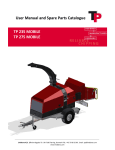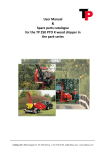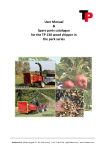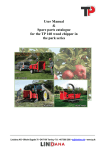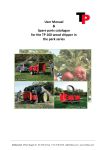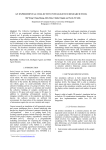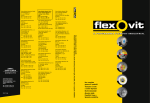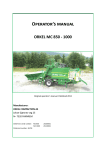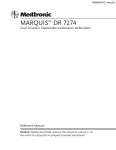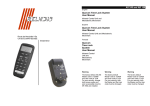Download User Manual and Spare Parts Catalogue TP 175 PTO
Transcript
User Manual and Spare Parts Catalogue TP 175 PTO Linddana A/S . Ølholm Bygade 70 . DK-7160 Tørring, Denmark Tel.: +45 75 80 52 00 . Email: [email protected] www.linddana.com Ó Copyright 2014 1 Introduction Congratulations on your new TP wood chipper. Linddana produces TP wood chippers of the finest quality by using the most modern production technologies, such as laser cutting, CNC technology and robot technology in bright and open production facilities. For safety reasons and in order to get the maximum benefit from your wood chipper, it is important you read the user manual before use. The user manual provides an explanation of safety, use and maintenance, to ensure working with the wood chipper will be safe and profitable. This manual has been translated from Danish. Linddana A/S Jørgen Due Jensen, CEO Your local dealer is always available with spare parts, advice and guidance. Dealer stamp 2 User Manual: TP 175 from date 10.09.2015 Ó Copyright 2014 2 EU Declaration of conformity Manufacturer: LINDDANA A/S, Ølholm Bygade 70, Ølholm, DK-7160 Tørring, Denmark hereby declares that Wood chipper: ______________________________________________ and accompanying extra equipment is in conformity with the requirements of the Machinery Directive (Directive 06/42/EC) and with the national legislation which translates this directive; furthermore, is in conformity with the following EC Directives: 2000/14/EC Furthermore it is stated that EN 13525 (harmonised standard), has been applied. Title: CEO Name: Jørgen Due Jensen Ølholm, 10 September 2015 User Manual: TP 175 from date 10.09.2015 3 Ó Copyright 2014 3 1 2 3 4 Contents Introduction .................................................................................................... 2 EU Declaration of conformity .......................................................................... 3 Contents .......................................................................................................... 4 Use and safety ................................................................................................. 6 4.1 4.2 4.3 4.4 5 6 Handling ........................................................................................................ 21 Before start-up .............................................................................................. 22 6.1 6.2 6.3 6.4 7 Opening and closing of disc housing .............................................................................. 22 Opening and closing of roller console ............................................................................ 25 Check the wood chipper before start-up........................................................................ 27 Fitting instructions ......................................................................................................... 28 Operating the wood chipper .......................................................................... 29 7.1 7.2 8 Setting the rpm for the feed rollers ............................................................................... 30 Starting the wood chipper ............................................................................................. 30 Maintenance ................................................................................................. 30 8.1 8.2 8.3 8.4 8.5 8.6 8.7 8.8 9 Maintenance schedule................................................................................................... 31 Hydraulic oil table .......................................................................................................... 31 Lubrication and oil change ............................................................................................. 32 Knives ............................................................................................................................ 33 Counterknife.................................................................................................................. 36 Scrapers......................................................................................................................... 37 Maintenance of the feed rollers .................................................................................... 38 V-belts ........................................................................................................................... 39 Hydraulics...................................................................................................... 40 9.1 9.2 9.3 10 10.1 10.2 10.3 10.4 11 12 13 14 14.1 14.2 14.3 14.4 14.5 14.6 4 Mandatory Instructions and Warnings ............................................................................. 6 Pictograms used ............................................................................................................ 18 Noise level ..................................................................................................................... 20 Environmental instructions ............................................................................................ 20 Replacement of hydraulic hoses .................................................................................... 40 Hydraulics diagram, TP 175 PTO without rpm monitor .................................................. 40 Hydraulics diagram, TP 175 PTO with rpm monitor ........................................................ 41 Instructions for rpm monitor TP PILOT ....................................................... 42 Overall operation........................................................................................................... 42 Programming ................................................................................................................. 44 Monitoring diagram ....................................................................................................... 47 Technical data ............................................................................................................... 47 Troubleshooting for the wood chipper TP 175 PTO .................................... 48 Warranty terms wood chipper ................................................................... 49 Technical data wood chipper ...................................................................... 51 Extra equipment......................................................................................... 52 TP CHIPKIT ..................................................................................................................... 52 TP TOOLKIT .................................................................................................................... 54 TP TRAILER HITCH .......................................................................................................... 55 Extended ejector spout .................................................................................................. 56 Lifter for ejector spout ................................................................................................... 56 Speed-up gear ............................................................................................................... 57 User Manual: TP 175 from date 10.09.2015 Ó Copyright 2014 14.7 15 Reverse gear .................................................................................................................. 57 Spare Parts Catalogue ................................................................................ 58 User Manual: TP 175 from date 10.09.2015 5 Ó Copyright 2014 4 Use and safety This TP wood chipper is specially designed as a stationary wood chipper, which chips wood in the form of branches, bushes and waste wood from windbreaks, parks, roadside trees, etc. It is strictly forbidden to make any technical changes to the machine. If this is done anyway waives all liability from Linddana A/S. 4.1 Mandatory Instructions and Warnings 4.1.1 Before use ALWAYS read the user manual before using the wood chipper. ALWAYS wear ear protectors, eye protection, close fitting safety clothing and safety shoes. ALWAYS ensure that the funnel is free of people, animals and other foreign bodies before starting the wood chipper. 6 User Manual: TP 175 from date 10.09.2015 Ó Copyright 2014 ALWAYS ensure that all of the guards are securely closed/fitted before starting the wood chipper. ALWAYS ensure that the tractor which drives the wood chipper is safely parked before starting the wood chipper. ALWAYS ensure there is less than 600 mm of clearance between the ground and the wood chipper's lowest funnel edge and that it stands on a level surface. ALWAYS ensure that the wood chipper is fitted to the tractor's three-point linkage. ALWAYS ensure that all of the safety devices function correctly before starting the wood chipper. This applies in particular to the safety bar's STOP function. User Manual: TP 175 from date 10.09.2015 7 Ó Copyright 2014 ALWAYS observe the ground conditions around the wood chipper. Falling down in the vicinity of the wood chipper is hazardous. ALWAYS ensure the length of the PTO shaft is suitable for the tractor in accordance with the recommendations from the supplier of the PTO shaft. ALWAYS ensure that the PTO shaft's tube guard and cover is intact and that the safety chains on the transmission shaft are safely fitted. 8 User Manual: TP 175 from date 10.09.2015 Ó Copyright 2014 NEVER allow anyone under 18 years of age operate the wood chipper (however, anyone who is 16 years old and over may do so under the supervision of an adult). NEVER operate the wood chipper if under the influence of alcohol or narcotic substances. NEVER operate the wood chipper on uneven surfaces. NEVER start the wood chipper without the ejector spout fitted. NEVER use the wood chipper in enclosed or poorly ventilated spaces, because of the danger of carbon monoxide poisoning. User Manual: TP 175 from date 10.09.2015 9 Ó Copyright 2014 NEVER point the ejector spout in the same direction as people or at an area that people move around in. A safe distance of 20 m must be maintained in the direction of where the woodchip is ejected. NEVER start or operate the wood chipper before it has been fitted to the tractor's three-point linkage. NEVER start or operate the wood chipper if it does not stand on the ground. 10 User Manual: TP 175 from date 10.09.2015 Ó Copyright 2014 NEVER use the wood chipper with material that is not wood. NEVER use the wood chipper to push trees, stumps, etc. NEVER transport equipment in the funnel, such as forest chains, axes, chainsaws, etc. User Manual: TP 175 from date 10.09.2015 11 Ó Copyright 2014 4.1.2 During operation ALWAYS push the safety bar into the STOP position if a dangerous situation arises (see chapter 7). ALWAYS keep body parts away from the funnel and wood chipper's other moving parts. ALWAYS stand at the side of the funnel when the wood chipper is chipping trees that have branches. ALWAYS push logs in from the rear of the log. 12 User Manual: TP 175 from date 10.09.2015 Ó Copyright 2014 ALWAYS use a rod to push short pieces of tree into the rollers. ALWAYS feed the wood chipper with the thick end of the log first. ALWAYS feed the wood chipper so that the tree crown points away from the funnel. User Manual: TP 175 from date 10.09.2015 13 Ó Copyright 2014 NEVER feed the tree crown into the wood chipper first. NEVER feed the wood chipper with the thin end of the log first. NEVER exceed the wood chipper's nominal rpm (see chapter 13). NEVER attempt to remove any trapped material from between the feed rollers before the wood chipper has stopped and the roller console has been opened as described in chapter 6.2. NEVER reach into the funnel to push wood into the rollers. NEVER open or remove the guard while the wood chipper is operating. 14 User Manual: TP 175 from date 10.09.2015 Ó Copyright 2014 4.1.3 In general ALWAYS disconnect the wood chipper from the tractor and ensure the disc has stopped moving before carrying out service or repairs. ALWAYS park the wood chipper on a level surface. ALWAYS after service or repair, ensure that all of wood chipper bolts are fitted and tightened securely and that all of the safety devices are fitted and function properly. ALWAYS store the accompanying user manuals in the manual box, so that they are accessible to the wood chipper user. ALWAYS comply with local public authority regulations when transporting the wood chipper on public roads. User Manual: TP 175 from date 10.09.2015 15 Ó Copyright 2014 ALWAYS keep the ejector spout within the width of the machine during transport. Remember to ensure that the ejector spout is securely fastened. ALWAYS keep the PTO shaft in the carrier shackle when removed. ALWAYS ensure that the knives, counterknives and rollers are kept sharp. This results in smoother in-feed, higher quality wood chips and less fuel consumption. 16 User Manual: TP 175 from date 10.09.2015 Ó Copyright 2014 NEVER operate the wood chipper on inclined or uneven surfaces. NEVER carry out service or repairs on the wood chipper while it is connected to the tractor. NEVER remove or open the guards before the disc has stopped moving and the PTO shaft has been removed. User Manual: TP 175 from date 10.09.2015 17 Ó Copyright 2014 4.2 Pictograms used Warning: Ejected Objects! Warning: Rotating knives! Warning: Safe distance of 20 m! Warning: Wait for disc to stop! Warning: Rotating rollers! Warning: Feed hazard! Warning: Feed hazard! Warning: Feed hazard! Warning: Rotating belts! Warning: Do not touch the funnel! Warning: Do not step on the funnel! Warning: Read the instruction manual before use! 18 Warning: Ensure that the funnel is free of people, animals and other foreign bodies! User Manual: TP 175 from date 10.09.2015 Warning: Feed hazard! Warning: Never carry out service or repairs on the wood chipper while it is connected to the tractor's PTO! Ó Copyright 2014 Warning: Max 1000 rpm, anti- Warning: Max 540 rpm, antiWarning: Max 1000 rpm, clockwise direction of rotation! clockwise direction of rotation! clockwise direction of rotation! Warning: Ensure the safety bar Warning: Do not park on works! uneven surfaces! Warning: Do not operate the wood chipper if it is raised! Warning: Do not operate the wood chipper if it is not fitted to the tractor's three-point linkage! Warning: Do not operate the wood chipper on uneven or sloping ground! Lifting point for forklift truck! Ear and eye protection mandatory! User Manual: TP 175 from date 10.09.2015 Lifting point for crane! 19 Ó Copyright 2014 4.3 Noise level The sound output level and the sound pressure level from the TP 175 PTO have been measured during use with the disc running at 1,000 rpm, powered by a tractor. The measurements have been conducted in accordance with testing provisions Directive 2000/14/EC, 3 July 2000 EN ISO 3744, 1995 ISO 11201, 1995 ISO 4871, 19 March 1997 EN 13525, 17 February 2005 The guaranteed sound output level which must be stated by the manufacturer in accordance with Directive 2000/14/EC is as follows: TP 175 PTO: 124 dB (A) relative to 1pW. The wood chipper’s sound pressure level at the operator’s position is measured in accordance with ISO 11201 and measured as: TP 175 PTO: 103 dB (A) The values stated above are subject to the common uncertainty of the measuring method and the estimated variation in a product series for the type of machine. Detailed information about the measurements and results and estimation of uncertainty are found in a detailed report which can be supplied on request. As a result of the actual sound levels, the wearing of ear protectors is mandatory when using the wood chipper. 4.4 Environmental instructions When changing hydraulic oil or engine oil, oil and used oil filters and air filters must be disposed of at an approved waste disposal station. Oil spillage must be avoided as far as possible. Should oil spillage occur, the spilled oil must be cleaned up and disposed of at an approved waste disposal station. Worn out parts must be disposed of for recycling. When the wood chipper is worn out it must be disposed of responsibly. Hydraulic oil and engine oil must be drained and disposed of along with oil filters and air filters at an approved waste disposal station. The rest of the wood chipper must be disposed of at an approved recycling centre. 20 User Manual: TP 175 from date 10.09.2015 Ó Copyright 2014 5 Handling Lifting point The wood chipper is equipped with a lifting point, which must be used whenever it is lifted by a crane or other lifting gear (with hooks). Transport using a forklift truck The wood chipper can also be lifted using a forklift truck. This is done by using the forklift fork pockets made for this purpose on both sides of the foot. Make sure that the forks of the forklift truck are inserted all the way through the fork pockets otherwise the wood chipper can tip over. User Manual: TP 175 from date 10.09.2015 21 Ó Copyright 2014 6 Before start-up 6.1 Opening and closing of disc housing The wood chipper must be disconnected from the tractor's PTO when the disc housing is opened and may only be re-connected after the disc housing has been closed again! Opening the disc housing 1. Ensure that the tractor's PTO has been disconnected. 2. Ensure that the disc is at a complete standstill by viewing through the air intake (see illustration below). 3. Turn the ejector spout so that it faces the opposite direction of the disc housing (see illustration below). 22 User Manual: TP 175 from date 10.09.2015 Ó Copyright 2014 4. Loosen the two or three bolts (dependent on model), which secure the disc housing top and bottom parts together (see the two illustrations below). 5. Open the top part of disc housing until it meets the stop (see illustration below). 6. Turn the disc until the yellow disc lock can go into one of the holes on the disc. The disc is now locked. Keep fingers away from the knives when the disc is being turned. As far as possible, the disc must always be locked when the disc housing is open (see illustration below). User Manual: TP 175 from date 10.09.2015 23 Ó Copyright 2014 Closing the disc housing 1. Free the yellow disc lock from the disc and turn the disc a few times to make sure that there are no objects in the disc housing. Exercise caution. Keep fingers away from the knives when the disc is being turned (see illustration below). 1. Lock the top part of the disc housing (see illustration below). 2. Tighten the two or three bolts (dependent on model) to secure together the top and bottom parts of the disc housing (see the two illustrations below). 24 User Manual: TP 175 from date 10.09.2015 Ó Copyright 2014 6.2 Opening and closing of roller console Opening the roller console To be able to open the roller console, the disc housing must be opened, as described in chapter 6.1. 1. Detach the stop bushing (1) which sits on the side of the roller console. 2. Lift the spring (2) from the roller console using multigrip pliers or similar. 3. Grip the handle (3) and lift the roller console and push the locking pawl (4) into the lock in the side of the roller console. The roller console is now open and secured from falling down. User Manual: TP 175 from date 10.09.2015 25 Ó Copyright 2014 Closing the roller console 1. Grip the handle (3) and pull out the locking pawl (4). 2. Lower the roller console back into position. 3. Lift the spring back on the roller console using multigrip pliers or a similar. 4. Fit the stop bushing (1). To close the disc housing again, see chapter 6.1. 26 User Manual: TP 175 from date 10.09.2015 Ó Copyright 2014 6.3 Check the wood chipper before start-up. 1. Open the disc housing as described in chapter 6.1. 2. Ensure that the wood chipper is free of any foreign bodies by turning the disc a few times by hand. Remove any foreign bodies. 3. Ensure that the knives run clear of the counterknives. 4. Ensure that the distance between the knives and counterknives is correct. The distance is stated in chapter 8.5. 5. Close the disc housing as described in chapter 6.1. 6. Ensure that all of the bolts, nuts and screws are tightened securely. 7. NB: Lubricate all of the lubrication points (see maintenance schedule, chapter 8.1). User Manual: TP 175 from date 10.09.2015 27 Ó Copyright 2014 6.4 Fitting instructions The wood chipper is designed to be fitted to a tractor three-point linkage and is delivered from the factory with a PTO shaft equipped with free running, with either 1 3/8" - 6 splines or 1 3/8" - 21 splines. The length of the PTO shaft must be adapted to the tractor in accordance with the instructions from the PTO shaft supplier (see the attached user instructions for the PTO shaft). Fitting the wood chipper to the tractor 1. Fit the wood chipper to the tractor's three-point linkage in the connections points as shown (see illustration above). The tractor must be safely parked with the brakes engaged during fitting. 2. Fit the PTO shaft to the tractor's power takeoff. NB: Ensure that the associated safety chain is fitted so that the guard cannot rotate during operation. The PTO shaft must have free running fitted on the wood chipper side. 3. If the wood chipper is equipped with TP PILOT, the 7-pole connector must be connected to the tractor's light connector. The computer in the TP PILOT is powered by the tractor's light connector. NB: Ensure therefore that the tractor's position light is on when the wood chipper is operating, 28 User Manual: TP 175 from date 10.09.2015 Ó Copyright 2014 7 Operating the wood chipper The wood chipper is equipped with two hydraulic rollers, which are controlled by a safety bar (2) with a reset handle (1) and a roller speed controller (3) (see illustration above). Position A The rollers rotate inwards and the material is drawn into the wood chipper. Position B The rollers rotate outwards and the material is pushed out of the wood chipper. Position 0 The rollers stop. When the safety bar has been pushed into position 0, the bar is locked. This is to ensure the rollers are not unintentionally re-started. To subsequently move the safety bar into position A or B, activate the reset handle. During start-up, the safety bar must always be in position 0. IN CASE OF POTENTIAL HAZARDS PUSH THE SAFETY BAR INTO THE STOP POSITION (position 0). User Manual: TP 175 from date 10.09.2015 29 Ó Copyright 2014 Roller speed Adjust the wood chipper's in-feed speed by turning the roller speed controller. Never operate too quickly with the rollers because the wood will act like a brake if the pressure on the disc is too great, with the risk of overheating, overloading and increased fuel consumption. Branches may become wrapped around the rollers if the rpm is too high. 7.1 Setting the rpm for the feed rollers The table shown below provides the recommended rpm of the feed rollers with the respective desired woodchip length. The speeds vary with the number of revolutions on the PTO shaft. The woodchip length can be regulated on the roller speed controller on the wood chipper to produce smaller woodchip lengths than indicated in the table. Woodchip length Model TP 175 PTO Disc rpm 1000 4 mm rpm 15 6 mm rpm 23 8 mm rpm 30 10 mm rpm 37 12 mm rpm 44 7.2 Starting the wood chipper When starting the wood chipper, attach only when the motor is running at idle speed or at as few motor revolutions as possible to avoid overloading the PTO shaft, gear box, tractor or wood chipper. NB: The wood chipper must stand on a secure and level surface during use and must be attached to the tractor's three-point linkage. 8 Maintenance The wood chipper must be inspected every day. This includes opening the disc housing and checking the feed, disc, knives, counterknives, triangle scraper and square scrapers. This will ensure that unexpected stoppages are avoided and prolong the life of the wood chipper. For all maintenance and repair work, the wood chipper and the driving power must be completely stopped before any work may be carried out. Tractor-mounted wood chippers must be placed on an even surface and be disconnected from the tractor’s PTO. 30 User Manual: TP 175 from date 10.09.2015 Ó Copyright 2014 8.1 Maintenance schedule X = for each stated time interval (X) = Only for the first time Interval=> hours Lubricate the PTO shaft1 Check the knives and counterknives (and sliver breaker - extra equipment) Tighten all bolts and nuts Lubricate disc main bearings2 Clean/lubricate tube connection for PTO shaft3 Lubricate roller bearings4 Tighten V-belts and check for wear and tear Change oil in the power shuttle (extra equipment)5 Change oil in the speed-up gear (extra equipment)6 Replace hydraulic pump return filter Reverse/replace counterknife Reverse/replace triangle and square scrapers Sharpen carrier on feed roller Change hydraulic oil7 Replace facing plate in top disc housing(extra equipment)8 Check ejector wings for wear and tear Check casing for wear and tear 86 X X 50 6 (X) X X X X X (X) (X) (X) 200 6 1000 6 X X X X X X X X X X 8.2 Hydraulic oil table Model type TP 175 PTO Standard oil type Hydraway HVXA 46 Bio-oil (optional)9 Hydraway SE 46 HP Quantity in l 18 l 1 Remove the PTO shaft and lubricate the four lubrication nipples using Uniway LI62 or equivalent lubricant. 2 Lubricate two lubrication nipples with Uniway Li62 or equivalent lubricant. 3 Remove the PTO shaft and pull apart the tube connection, clean and lubricate it. 4 Lubricate two lubrication nipples with Uniway Li62 or equivalent lubricant. 5 Drain the old oil and fill with new oil W80/90 until the level is visible in the oil sight glass, 1.6 l. 6 Drain the old oil and fill with new oil W80/90 until the level is visible in the oil sight glass, 1 l. 7 Drain the hydraulic oil and fill with new oil. See above in the hydraulic oil table for oil type and amount. 8 If fitted, change the facing plate in the top disc housing, as necessary. 9 The interval between changing oil can be extended by using biodegradable hydraulic oil, which can be purchased as extra equipment. User Manual: TP 175 from date 10.09.2015 31 Ó Copyright 2014 8.3 Lubrication and oil change The wood chipper is filled at the factory with mineral hydraulic oil as standard (bio-oil may be purchased as extra equipment). See the hydraulic oil table in point 8.2. When replacing the oil, use the same type of oil or an oil with equivalent specifications. Do not mix oils of different types/brands. Old hydraulic oil must be handed in to the municipal receiving station. Lubricate the nipples on the wood chipper according to the maintenance schedule, using Statoil Uniway Li62 or an equivalent product that can be mixed with Uniway Li62. Replacing of hydraulic oil and return filter 1. Open the filler neck (1). 2. Unscrew the drain plug (2) and capture the oil in a container for suitable disposal. 3. When the tank is almost empty, suck the tank empty using an oil suction device. 4. Replace the return filter (3) with a new filter. 5. Screw the drain plug (2) back on. 6. Remove the filler neck (1) and the breather plug (4) and slowly fill with new hydraulic oil. Fill the oil until the oil level is at the middle of the level glass (5). 7. Lastly, re-fit the filler neck (1) and the breather plug (4). 32 User Manual: TP 175 from date 10.09.2015 Ó Copyright 2014 8.4 Knives The wood chipper is fitted with two knives. The knives must always be changed as a set. The knives belong together in sets, also when they are ground so that they are always of equal width. If the knives are not of equal width, the disc will be out of balance, which will lead to unnecessary strain on the bearings and vibrations in the whole wood chipper. Always store the knives in the box provided (see image above). User Manual: TP 175 from date 10.09.2015 33 Ó Copyright 2014 Replacing the knives 1. Open the disc housing as described in chapter 6.1. 2. Remove the bolts (2) that hold the knives and clamping plates (3)/sliver breaker securely to the disc. 3. Remove the knives and sharpen/replace. 4. Carefully clean the knives (1), clamping plates (3)/sliver breaker and contact faces. 5. When fitting the knives (1), the bolts (2) must be lightly oiled (m=0.125), i.e. light oil, WD 40 or an equivalent product. Do not use copper grease, MoS2 or similar low friction grease. 6. Check that the distance between the knife edge and the counterknife is set correctly to D (see point 8.5). Check all of the knives. 7. Tighten the bolts (2) to 110 Nm / 11 KPm. Use a torque spanner for this purpose (available as extra equipment). 8. Finally, close the disc housing as described in chapter 6.1. 34 User Manual: TP 175 from date 10.09.2015 Ó Copyright 2014 Sharpening knives It is very important for the quality of woodchip that the knives are sharp. They must be checked at least once a day. The grinding interval of the knives can be prolonged by grinding them regularly with a carborundum stone. The grinding process must be wet grinding with a header. Never use an angle grinder or a similar tool for grinding the knives. When grinding the knives, ensure that the width of the knives in the set are uniform. Their widths must be the same to keep the disc in balance. This means that the knives must always to be ground in sets. The knives must not be ground down to a width of less than 75 mm. After that they must be discarded. The edge of the knives must be ground at an angle of 30° User Manual: TP 175 from date 10.09.2015 35 Ó Copyright 2014 8.5 Counterknife The counterknife in the wood chipper is used by the knife to cut the wood. The counterknife must have a sharp edge otherwise the wood will bend and the cutting face become frayed. The wood chipper is equipped with a vertical counterknife in each side of the in-feed and a horizontal counterknife in the base. The horizontal counterknife has two cutting edges and therefore can be reversed. Changing the counterknife D = 1.5 mm 1. Open the disc housing as described in chapter 6.1. 2. Open the roller console as described in chapter 6.2. 3. Remove the bolts that hold the horizontal counterknife in place. 4. Take out the counterknife and reverse/replace. 5. Carefully clean the counterknife and contact surface. 6. Re-fit the counterknife and adjust the distance between the knife edge and the counterknife to distance D using a precision feeler gauge (see illustration above). 7. The bolts in the horizontal counterknife must be tightened to 100 Nm / 10 KPm. The bolts in the vertical counterknife must be tightened to 50 Nm / 5 KPm. Use a torque spanner for this purpose (available as extra equipment). 8. Once the counterknives have been reversed or replaced and all of the bolts have been tightened, close the roller console as described in 6.2. 9. Finally, close the disc housing as described in chapter 6.1. 36 User Manual: TP 175 from date 10.09.2015 Ó Copyright 2014 8.6 Scrapers The wood chipper is equipped with two square scrapers on the disc and a triangle scraper in the disc housing. The purpose of the scrapers is to remove material that can get stuck by the knives. At the same time, the square scraper removes material which falls off in front of the disc. This reduces fuel consumption and wear on the casing. The square scraper can be reversed once, before being replaced, while the triangle scraper should always be replaced when they are worn. The square scrapers belong together as a set and must always be replaced in pairs. Changing the scrapers 1. Open the disc housing as described in chapter 6.1. 2. Remove the two square scrapers (1) and the triangle scraper (2). 3. Reverse the square scraper (1) so that the worn side faces into the disc rotation point. If both sides are worn, replace the scrapers. The triangle scraper (2) cannot be reversed and must always be replaced. 4. Clean the contact surfaces and scrapers (1, 2) and re-fit. 5. Finally, close the disc housing as described in chapter 6.1. User Manual: TP 175 from date 10.09.2015 37 Ó Copyright 2014 8.7 Maintenance of the feed rollers The feed rollers draw material into the disc and the knives. The carrier on the bottom feed roller must be kept sharp in order to maintain the feed force. Sharpening the lower roller 1. Open the disc housing as described in chapter 6.1. 2. Open the roller console as described in chapter 6.2. 3. There is now access to the lower roller and the roller's carriers can be sharpened using an angle grinder. NB: The weld seams must not to be ground away! 4. Remove the disc lock and set the operation bow in a forward or reverse position. 5. Carefully turn the disc (keep fingers away from the knives when the disc is being turned). When the disc rotates, the feed roller follows, and all of the carriers can thus be sharpened. 6. Once all of the carriers have been sharpened, close the roller console as described in chapter 6.2. 7. Finally, close the disc housing as described in chapter 6.1. 38 User Manual: TP 175 from date 10.09.2015 Ó Copyright 2014 8.8 V-belts The feed rollers are driven hydraulically. The hydraulic pump for the feed rollers is driven by Vbelts. The V-belts must be checked regularly or whenever the belts are suspected of being slack. Adjusting the V-belts 1. Open the disc housing as described in chapter 6.1. 2. Remove the four bolts (1) which hold the horizontal counterknife. 3. Adjust the V-belt using the adjusting screw (2). The V-belts must be set so that the V-belt gauge shows 4.4–4.7 kg (new belts) or 3.8–4.1 kg (used belts) with bending on the V-belts of 5.7 mm at the measuring point 3. The V-belt gauge may be purchased as extra equipment. 4. Once all of the V-belts are set, close the disc housing as described in chapter 6.1. User Manual: TP 175 from date 10.09.2015 39 Ó Copyright 2014 9 Hydraulics 9.1 Replacement of hydraulic hoses If a hydraulic hose bursts it must be replaced. All TP hydraulic hoses have in printed a part number in the fitting. This part number is used to identify the hydraulic hoses. When replacing hydraulic hoses, always use original TP hoses. 9.2 Hydraulics diagram, TP 175 PTO without rpm monitor 40 User Manual: TP 175 from date 10.09.2015 Ó Copyright 2014 9.3 Hydraulics diagram, TP 175 PTO with rpm monitor User Manual: TP 175 from date 10.09.2015 41 Ó Copyright 2014 10 Instructions for rpm monitor TP PILOT 10.1 Overall operation TP PILOT provides the option for monitoring the revolutions of the engine and feed rollers, and sounding an alarm when low or high limit values are exceeded. TP PILOT is pre-programmed for several types of machine. Overview of the monitor 1. Display marker Indicates which function is currently shown in the display. 2. Display 3. Output to junction box 4. NEXT Change between different display indications. 5. CHANGE Programming and resetting of numerical values. 6. SET Starting changes of the marked value and changing of digits in display. 42 User Manual: TP 175 from date 10.09.2015 Ó Copyright 2014 Different functions and display indications Use the NEXT key Symbol: to change between the following display indications: Term: Disc Programmable rpm monitor for disc Roller Programmable rpm monitor for roller Work time (User can reset this) Work time total (Cannot be reset) Type Pilot programme The pilot programme depends on the model type Display: 12 – 9999 (rpm) 1 – 9999 (rpm) 0.00 – 99.59 9999 0.00 – 99.59 9999 1 – 26 (hours. minutes) (hours) (hours . Minutes) (hours) (programmes) Explanation for operation keys The TP PILOT is equipped with an internal memory which saves all values when the power is cut. NEXT Press the key to change between the different display indications and thus between the different functions of the monitor. With every press of the key, the position of the marker/display indication changes one step. The key is also used to leave the change menu (see next section). CHANGE Use the key to change/delete the values that are to be programmed. Before using this key, the applicable value that is desired to be changed should flash. This is done using . SET Use the key for programming (change/delete) values in the computer, e.g. entering alarm values for high or low rpm. User Manual: TP 175 from date 10.09.2015 43 Ó Copyright 2014 10.2 Programming The following parameters can be finely-adjusted, as needed. Parameter L = Low h = High T(ype) Meaning Comment Lowest rpm Deviation from nominal rpm If the wood chipper is loaded to under "lowest rpm", the feeding is uncoupled so that the wood chipper has the possibility of reaching normal rpm, at which point the rollers are recoupled. Nominal rpm Nominal rpm, which the disc must maintain and at which point the in-feed starts. Machine type According to the set-up table for machine types Triggers an alarm on the feed roller. If the rpm on the feed roller exceeds the upper limit value (Roller flashes) the display will blink between the rpm value and high. Adjust the roller speed by turning the roller speed controller clockwise. When the roller speed falls below the limit value again, the current rpm is displayed. 10.2.1 Entering code When changing parameters and machine type, the code 1001 must first be entered. Procedure for entering code: use the key to select what is required to be changed on the display. Press the key for one second until _c0000 flashes. Use the key to enter the first digit of the code number. Press the key to move the marker to the next digit in the number and so on, until all the digits are changed/programmed. The required parameters can now be changed. Finally, press the key once to leave the menu. The code must be entered with every change. 44 User Manual: TP 175 from date 10.09.2015 Ó Copyright 2014 Here you can see an example of the programming of limit values on the disc. Example of changing low limit value to 800 rpm and high limit value to 1000 rpm Press the key: The display Explanation: shows: 0 Press the key repeatedly until the display marker is next to L_850 Press the key for one second and enter the access code. L lights up on the left and the first digit (four digits in total) flashes. L X800 Press the key until the digit has the correct value. NB: Zero is shown as _ in this position. L_X00 Press the key to set/change the next digit (the second digit will now flash). L_800 Press the key until the desired digit is correct. L_8X0 Press the key to set/change the next digit (the third digit will now flash). L_850 Press the key until the desired digit is correct. L_85X L_850 h_980 hX980 h1980 h1x80 h1080 h10X0 h1000 h100x h1000 Press to set/change the last digit. Press the key until the desired digit is correct. Press the key and "h" (high) will light up to the left and the first digit (of four) will flash. Press the key until the desired digit is correct. NB: Zero is shown as _ in this position. Press to set/change the next digit (the second digit will now flash). Press the key until the desired digit is correct. Press to set/change the next digit (the third digit will now flash). Press the key until the desired digit is correct. Press to set/change the last digit. Press the key until the desired digit is correct. Press to exit the programming menu. When an alarm limit on the disc is exceeded, the current rpm is still shown while the feed rollers are stopped. If the disc has been under the lower limit value, the feed rollers will start when the disc’s rpm is above the set upper limit value 'h' (e.g. 1000 rpm). Set-up table for included machine types. Model TP 175 PTO Disc rpm 1200 rpm 1 L 850 rpm 1 h 980 User Manual: TP 175 from date 10.09.2015 Type No. 15 45 Ó Copyright 2014 Work time on the wood chipper: Displaying the rotation time on the wood chipper With this display, the display marker is shown next to work time . The work time will be shown as illustrated in the figure below. In the example, the wood chipper has operated for 72 hours and 57 minutes. 72:57! Over 99:59 hours/minutes, only whole hours are shown. Resetting the rotation time on the wood chipper Resetting the rotation time (operation time) on the wood chipper can be done at any time. First press the key until the display for work time Press the key: The display shows: 72:57 (example) 72:57 00:00 appears. After this, the following is typed in: Explanation: Press repeatedly until the display marker is next to Press the key for five seconds until the number blinks. Press the key to reset the rotation time. NB: Total hour counter (bottom vertical marker) cannot be reset. It is used for registering the wood chipper’s total work time. 46 User Manual: TP 175 from date 10.09.2015 Ó Copyright 2014 10.3 Monitoring diagram 1. Disc, inductive sensor 2 Rollers, hall sensor 3 Valve 4 Power, 12V 10.4 Technical data Display: Six digits Power supply: 12 VDC / 1.24 A Temperature ranges: TP PILOT is fully operational in the temperature range -10 to +70 °C. Pulse signals from sensor: Max. 225 pulses/second User Manual: TP 175 from date 10.09.2015 47 Ó Copyright 2014 11 Troubleshooting for the wood chipper TP 175 PTO Check possible causes before contacting the supplier. Problem/Possible cause Solution The rollers are not turning round satisfactorily: The operation bow is in the 0 position Not enough oil in the hydraulics system The roller speed controller is screwed out too far The stationary roller is blocked The bypass valve is dirty The rpm monitor is blocking operation Put the operation bow in the A position Fill up with hydraulic oil Turn up the flow Clean under and behind the roller Clean the bypass valve Increase the rpm on the disc The rollers are not pulling satisfactorily: Not enough flow The V-belts are too slack The hydraulic oil is becoming too hot Poor viscosity of the hydraulic oil The hydraulic filter is blocked The oil pump is worn or damaged The oil engine is defective The pressure control valve at the roller speed controller is dirty Screw out further the roller speed controller valve (opened) Tighten the V-belts Let the wood chipper cool down while checking why Change the hydraulic oil Replace the hydraulic filter Replace the hydraulic pump Replace the oil engine Clean the pressure control valve Unsatisfactory woodchip quality: The knives are blunt The counterknife is worn The knives are worn down too far The distance between knife and counterknife is too big Sliver breaker not mounted or worn Sharpen the knives Reverse/replace counterknife Replace the knives Adjust the distance between the knives and counterknife Fit or replace the sliver breaker Poor ejection of woodchip: Not enough driving power Scraper is worn The facing plate in the top part Too low rpm on the wood chipper 48 Not enough power on the PTO shaft or the engine Replace the scrapers Remove the facing plate from the top part Increase speed to maximum revolutions User Manual: TP 175 from date 10.09.2015 Ó Copyright 2014 12 Warranty terms wood chipper The warranty is valid for 36 months from date of purchase and covers any identifiable defects in materials or manufacturing defects. The warranty covers faulty components, which will be repaired or replaced. Transport costs and labour costs involved in replacements are the responsibility of the customer. When any claims are made, the replaced parts must be sent to Linddana for examination. Linddana alone decides whether the claim can be approved. The following is an excerpt from Linddana’s Terms of Sales and Delivery (items 4 and 5). Warranty terms LINDDANA provides a 36-month warranty that covers any repairs of faults or defects in construction, materials or manufacturing. This warranty shall not cover defects or faults due to inadequate maintenance, incorrect installation, alterations made by the buyer or incorrect use of the product. If non-original parts are used, the warranty is void. Furthermore, the warranty shall not cover normal wear and tear. LINDDANA's obligations under the warranty shall be conditional on the buyer's documentation that any ascertained defect or fault has not been caused by circumstances excluded from the warranty; cf. above. LINDDANA shall be entitled and under an obligation to remedy all defects caused by faults of design, materials or production. LINDDANA alone shall decide whether remedial action shall be in the form of repair or replacement of the defective part or parts. Where repairs are carried out, the buyer shall be obliged to deliver the item sold to a workshop indicated by LINDDANA, and collect it, at no cost to LINDDANA. When the defective part or parts are replaced, the buyer shall be obliged to send the defective parts to LINDDANA at no cost to LINDDANA. LINDDANA shall be entitled to deliver a substitute product to replace defective products. The buyer shall inform LINDDANA of faults or defects in the product sold, not later than eight days after the defect is discovered or should have been discovered by the buyer. If the buyer does not inform LINDDANA before this time limit has expired and before the warranty period has expired, the buyer shall forfeit the right to make any claims arising from the defect or deficiency. LINDDANA assumes no other liability for such defects. This applies to any losses that may be caused by the defect, including operational losses, or loss of earnings and other consequential financial losses. User Manual: TP 175 from date 10.09.2015 49 Ó Copyright 2014 The warranty does not cover: · · · · · · · · 50 Defects that can justifiably be attributed to inappropriate use. Use of non-original spare parts, including wearing parts. Incorrect adjustment or misuse of the wood chipper. Use of wrong lubricant or hydraulic oil. Wear on the cross on the PTO shaft. Tightening spring for rollers. V-belts Knives and counterknife which break because of foreign bodies in the wood chipper. User Manual: TP 175 from date 10.09.2015 Ó Copyright 2014 13 Technical data wood chipper Type Chipping principle Disc diameter, mm PTO rpm Total number of knives Power requirement min./max. kW/(HP) Max. wood diameter, mm Chip length, mm Knife position, mm Weight, kg Height, mm Width, mm Length, mm TP 175 PTO Disc chipper 660 1000 4 29–66/(40–90) 175 4–12 12 519 2294 1230 2065 We reserve the right to make changes to the design and specifications without notice. Dimensional drawing for TP 175 PTO User Manual: TP 175 from date 10.09.2015 51 Ó Copyright 2014 14 Extra equipment 14.1 TP CHIPKIT The TP CHIPKIT includes four sliver breakers which are fitted to the knife opening in the disc and a facing plate, which is fitted to the top in the disc housing. The TP CHIPKIT provides significantly improved wood chip quality. If woodchip quality is not an important factor, it will be beneficial if the facing plate and the sliver breakers are removed. This will increase the capacity of the wood chipper and save fuel. It is also recommended that the facing plate and the sliver breakers are removed when chipping wet conifer wood with a lot of needles. This ensures good ejection. Replacing the facing plate 1. Open the disc housing as described in chapter 6.1. 2. Remove the facing plate (1), which is fitted with two bolts in the side of the top disc housing. 3. Replace the facing plate (1) if it is worn. 4. Fit the new facing plate (1). 5. Finally, close the disc housing as described in chapter 6.1. 52 User Manual: TP 175 from date 10.09.2015 Ó Copyright 2014 Replacing the sliver breakers 1. Open the disc housing as described in chapter 6.1. 2. Remove the bolts that secure the knife and clamping plate/sliver breaker (2) to the disc. 3. Replace the sliver breakers (2). 4. Carefully clean the knife, sliver breaker (2) and contact surface. 5. When fitting the sliver breaker, the bolts must be lightly oiled (m=0.125), i.e. light oil, WD 40 or an equivalent product. Do not use copper grease, MoS2 or similar low friction grease. 6. Check that the distance between the knife edge and the counterknife is set correctly to D (see point 8.5). 7. Tighten the bolts to 110 Nm / 11 KPm Use a torque spanner for this purpose (available as extra equipment). 8. Finally, close the disc housing as described in chapter 6.1. User Manual: TP 175 from date 10.09.2015 53 Ó Copyright 2014 14.2 TP TOOLKIT The TP TOOLKIT contains: · · · · · · · · 54 Tool bag Combination wrench 13 mm Combination wrench 19 mm Grinding stone"Flexovit" Precision feeler gauge 1.5 x 150 mm Torque wrench 5-30 kPm WBW-VLL extender 1/2" - 250 mm WBM TOP 1/2" - 6 KT/19 mm User Manual: TP 175 from date 10.09.2015 Ó Copyright 2014 14.3 TP TRAILER HITCH TP TRAILER HITCH is a trailer hitch that is fitted using four bolts at the front of the wood chipper's three-point linkage and with two bolts at the rear in the wood chipper's foot. TRAILER HITCH allows the option of attaching a trailer for collecting woodchip behind the wood chipper. The maximum loads for the trailer hitch is given in the table below. Maximum loads Coupling point Total weight of trailer Kg 500 5000 NB: The use of the trailer hitch with transport on public roads must comply with traffic regulations in the respective country. User Manual: TP 175 from date 10.09.2015 55 Ó Copyright 2014 14.4 Extended ejector spout The extended ejector spout is used to control the flow of woodchip over a longer horizontal distance. 14.5 Lifter for ejector spout The lifter for the ejector spout is used to increase the height of the ejected woodchip. This may be necessary if the woodchip us to be loaded into a truck or trailer. 56 User Manual: TP 175 from date 10.09.2015 Ó Copyright 2014 14.6 Speed-up gear The speed-up gear is used with tractors with PTO that can operate with a max. 540 rpm. The speed-up gear operates at a ratio of 1:1.9, and thus ensures that the wood chipper disc operates at 1000 rpm, even though the tractor's PTO only operates at 540 rpm. When speed-up gear is mounted the PTO height is reduced with 220 mm. 14.7 Reverse gear The reverse gear transforms the rotational direction from the tractor to the wood chipper in the ratio 1:1. This is necessary if the wood chipper must be fitted at the front. With reverse gear mounted the PTO height is reduced with 105 mm. User Manual: TP 175 from date 10.09.2015 57 15 Spare Parts Catalogue Linddana A/S . Ølholm Bygade 70 . DK-7160 Tørring, Denmark Tel.: +45 75 80 52 00 . Email: [email protected] www.linddana.com




























































